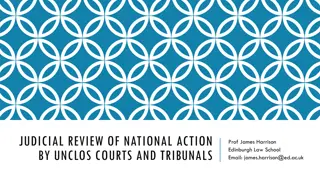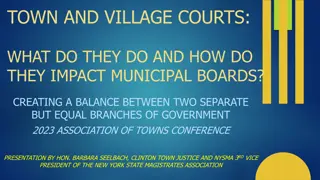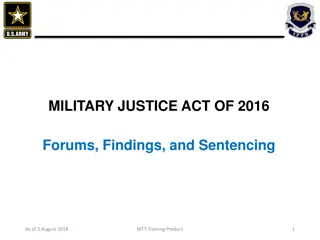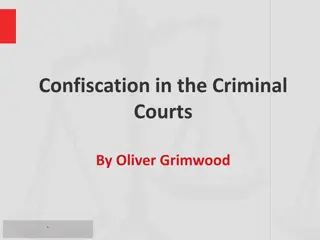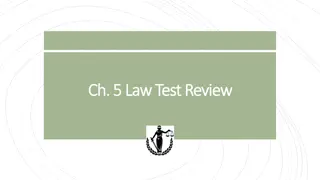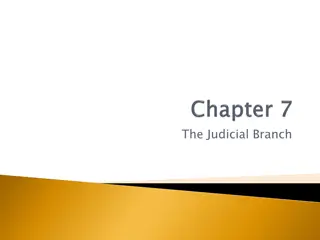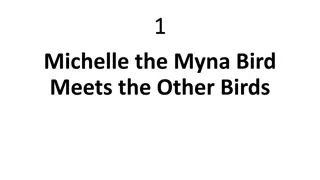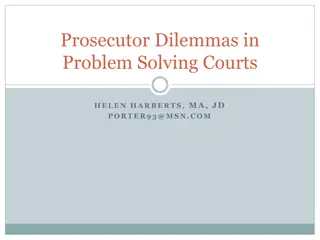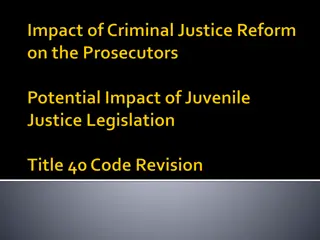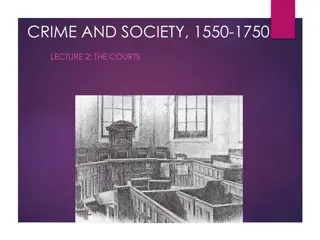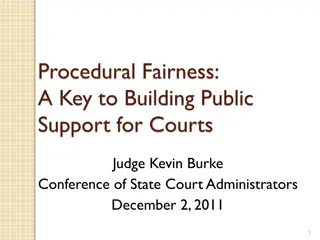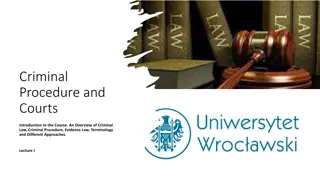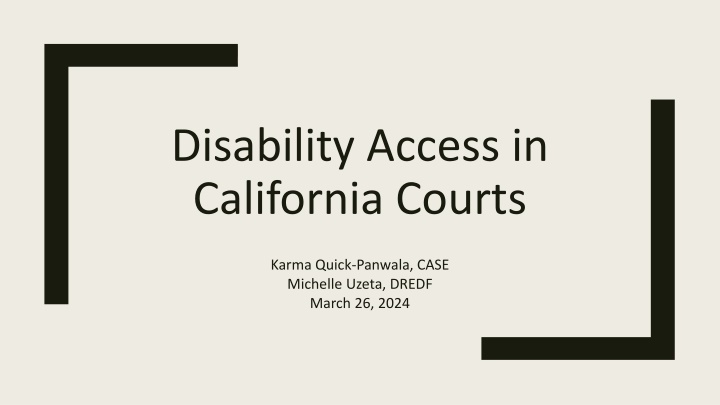
Accessible California Courts: Ensuring Equal Legal Access for People with Disabilities
Learn about the importance of accessibility in California courts for individuals with disabilities, including laws requiring court services to be accessible, obtaining reasonable accommodations, and the impact of access barriers on people with disabilities in the legal system.
Download Presentation

Please find below an Image/Link to download the presentation.
The content on the website is provided AS IS for your information and personal use only. It may not be sold, licensed, or shared on other websites without obtaining consent from the author. If you encounter any issues during the download, it is possible that the publisher has removed the file from their server.
You are allowed to download the files provided on this website for personal or commercial use, subject to the condition that they are used lawfully. All files are the property of their respective owners.
The content on the website is provided AS IS for your information and personal use only. It may not be sold, licensed, or shared on other websites without obtaining consent from the author.
E N D
Presentation Transcript
Disability Access in California Courts Karma Quick-Panwala, CASE Michelle Uzeta, DREDF March 26, 2024
Agenda What laws require court services, programs and activities to be accessible? How to get reasonable accommodations from the court. Effective communication in the courts. 2
Why is access to the court important? The 2022 Justice Gap Measurement Survey showed that 82% of low- income households with disabilities experienced at least one civil legal problem in the past year, and 48% experienced at least five Several of the top ten most burdensome civil legal problems, including employment discrimination, access to healthcare, disputes over disability benefits and poor working conditions, disproportionately affect people with disabilities People with disabilities are over-represented in the criminal justice system as compared to people without disabilities The rate of violent crimes against people with disabilities is estimated to be 4x the rate for people without disabilities Approximately two in five (38%) of people incarcerated in state and federal prisons report having at least one disability 3
Why is access to the court important? (continued) People with disabilities experience a range of disability-related barriers as they use the legal system Court technology platforms that are not accessible to blind users Courtrooms lack physical access (e.g., witness or jury boxes are inaccessible; inaccessible entrances and restrooms; etc.) Failure to accommodate (e.g., allowing service animals in the courtroom) No effective communication (e.g., failure to provide captioning or sign language interpretation) Access concerns are compounded by stigmas (e.g., people with disabilities are not credible; lack the ability to make decisions in their legal matters; and don t deserve redress for harms they experience) 4
What Laws and Rules Require California s Courts to be Accessible? Americans with Disabilities Act Title II California Government Code Section 11135 Rule 1.100 of the California Rules of Court Possibly... Section 504 of the Rehabilitation Act 5 5
Americans with Disabilities Act (ADA) Federal law applicable to all state and local government entities, including CA courts. Prohibits courts from excluding people with disabilities from participating in or benefitting from their services, programs, or activities, or otherwise discriminating against them Intended to ensure that court users with disabilities have equal and full access to the court system. Parties Spectators Attorneys Witnesses Jurors People with disabilities includes persons who have a physical or mental medical condition that limits one or more major life activities, have a record of such a condition, or are regarded as having such a condition. Examples of major life activities include walking, seeing, hearing, speaking, or breathing, or caring for oneself. 6
California Government Code 11135 State law prohibiting discrimination based on disability by: any program or activity that is conducted, operated, or administered by the state or by any state agency any program or activity that is funded directly by the state any program or activity that receives any financial assistance from the state Incorporates by reference the protections and prohibitions contained in the ADA Rule 1.100 - California Rules of Court Allows court participants with disabilities, including lawyers, parties, witnesses, and jurors, to request reasonable accommodations from the court. Sets forth the policies and procedures of the Court for requesting, processing, and appealing the denial of accommodation requests 7
What Do These Authorities Require? Access to Facilities Reasonable Accommodations Effective Communication 8
Access to Facilities State courts are required to operate each service, program, or activity so that it is readily accessible to and usable by individuals with disabilities when looked at in its entirety Does not necessarily require a public entity to make each of its existing facilities accessible Does not require the courts to take any action that would threaten or destroy the historic significance of an historic property Compliance may be achieved through other methods (e.g., reassignment of services to accessible buildings, delivery of services at alternate accessible sites, alteration of existing facilities and construction of new facilities) Newly constructed and altered facilities must be designed to be accessible ADA Standards for Accessible Design: https://www.ada.gov/law-and-regs/design-standards/ Access Board s Designing Accessible Courthouses : https://www.access-board.gov/ada/additional- resources/designing-accessible-courthouses.html California Accessibility Standards: https://codes.iccsafe.org/content/CABC2022P1/chapter-11b-accessibility- to-public-buildings-public-accommodations-commercial-buildings-and-public-housing 9
Reasonable Accommodations A reasonable accommodation is a change to a policy, practice, or procedure, necessary to avoid discrimination based on disability E.g., change to policy Allowing service animals E.g., changes to practices or procedures Reassign a hearing to an accessible site, or Adjust schedules (as long as legal deadlines are not missed) Provision of assistive devices or services to ensure effective communication (e.g., captioning services, ASL interpreter, assistive listening devices, readers) Does not include accommodations of a strictly personal nature like: personal care assistant to help with eating or using the restroom personal devices or items like hearing aids, walkers/wheelchairs or medication a free lawyer, paralegal, or assistant transportation 10
Requesting Case-Related Reasonable Accommodations from the Court The California courts have a system for requesting accommodations for court cases Courts must have at least one ADA Coordinator to handle accommodation requests. Requests can be made by: Calling and asking the ADA Coordinator, Sending a letter to the ADA Coordinator, or Filling out form MC-410 (Judicial Council form Request for Disability Accommodation ) https://www.courts.ca.gov/documents/mc410.pdf Accommodations can also be requested in open court, and the court can handle the request. BUT - the court must first ask if the requestor waives confidentially. If not waived, court should recess and address in chambers. The court must address the request without an evidentiary hearing or the use of a court reporter. The request is not made part of the case file and must be kept strictly confidential. 11
Practice Tips Accommodations should be requested as far in advance as possible Helps ensure full consideration of the request ADA coordinator may need additional information Helps ensure there is sufficient time to arrange the accommodation Include date/time; case # and type of case; reason why you need the accommodation (related to your disability); any other information about the request you believe is important. Both CRC 1.100 and MC-410 form say to request accommodations at least 5 days in advance NOT a bright line cut off for requests (conflicts with ADA) Requests must be considered regardless of when the request is made Important to document / make a record of your request, and any related communications Best to use the MC-410 form 12
After an Accommodation Request is Made Court may grant the requested accommodation in whole or in part Court may offer an alternative accommodation Court s obligation is to provide an accommodation that will allow effective participation in court s services, programs and activities (not necessarily what the person with the disability wants) Effective communication context regulations expressly require primary consideration of requested auxiliary aide or service If the alternative suggested is not effective, ask for review or appeal 13
After an Accommodation Request is Made (continued) Court may deny the accommodation Request does not meet the requirements of Rule 1.100 Undue financial or administrative burden Fundamentally alters the nature of the court s service, program, or activity Court must communicate the reasons for the denial in writing Triggers the right to appeal 14
Challenging an Accommodation Denial Rule 1.100 states: If denial is by non-judicial personnel, submit a written request for review to the presiding judge or designated judicial officer within 10 days If denial is made by a judge or other judicial officer, file a petition for writ of mandate in the appropriate reviewing court (appellate division or Court of Appeal) within 10 days 15
Challenging an Accommodation Denial (continued) Materials from the Judicial Council are... inconsistent and confusing MC-410 form refers to Rule 1.100 Brochure entitled Disability Accommodations in California Courts states that if the request was denied by a court staff person (not a judge or judicial officer), the requestor must give the ADA coordinator or the court a letter objecting to the denial within 10days https://www.courts.ca.gov/documents/Disability- Accommodations-in-California-Courts.pdf The 10-day timeline starts on the date the denial was delivered in person or the date it was mailed. Warning! Even if the denial was received by mail, there is no extra time provided to file for review or petition. 16
Survey of Superior Court Websites Most provide link to MC-410 form Some reference and/or provide link to Rule 1.100 Few provide a link to the Judicial Council s Disability Accommodations in California Courts Brochure Not all provide contact information for the ADA Coordinator None provide sample requests for review or appeals None provide information about how to contact the presiding judge or how to get help or guidance on writs Very few advise people of the 10-day period within which case-related denials must be appealed some confuse readers by referring to their general ADA grievance policies (referencing a 30 or 60-day timeline for filing); or by outlining / providing for an informal review or reconsideration process 17
Examples Yuba County Superior Court: https://www.yuba.courts.ca.gov/general- information/americans-disabilities-act-ada Link to the MC-410 form; nothing on Rule 1.100 Link to County s general ADA grievance procedure which has 60-day timeline for filing complaints Nothing on 10-day timeline for accommodation appeals Napa County Superior Court: https://www.napa.courts.ca.gov/general- information/ada- information#:~:text=ADA%20Coordinator,should%20you%20have%20an y%20questions Only references general ADA grievance / reconsideration process; nothing on 10-day timeline 18
Examples (continued) Shasta County County Superior Court: https://www.shasta.courts.ca.gov/General-Info/ADA.shtml No links to MC-410 or Rule 1.100 No ADA coordinator or contact identified References right to appeal, but not the 10-day timeline or any details San Benito County Superior Court: https://www.sanbenito.courts.ca.gov/general-information/ada-policy No appeal information provided whatsoever 19
The Result? A process that highly disfavors people with disabilities! DREDF would like to hear your stories. muzeta@dredf.org muzeta@dredf.org 20
Effective Communication
What is Effective Communication and Why is it Important? People who have vision, hearing, or speech disabilities ( communication disabilities ) use different ways to communicate. Effective communication is communication that allows a person with a vision, hearing, or speech disability to communicate with, receive information from, and convey information to, a covered entity like the courts. Effective communication is essential to ensuring equal access to and use of the courts services, programs and activities! 22
What do Disability Rights Laws say about Effective Communication? The ADA provides that public entities must take appropriate steps to ensure that communications with people with disabilities are as effective as communications with others Applies to the California Courts The right to effective communication extends to all people with communication disabilities involved in court proceedings, including: parties witnesses lawyers Jurors spectators. 23
What Steps Must Courts Take to Ensure Communication is Effective ? Courts must provide people with disabilities with auxiliary aids and services where necessary to give them an equal opportunity to participate in, and enjoy the benefits of the court s services, programs, or activities. 24
Examples of Auxiliary Aids and Services Qualified interpreters on-site or through video remote interpreting (VRI) services Qualified readers Taped texts Notetakers Audio recordings Written materials / exchange of written notes Brailled materials and displays Assistive listening devices or systems Screen reader software Open and closed captioning, including real-time captioning Magnification software Secondary auditory programs (SAP) Voice, text, and video-based telecommunications products and systems, including text telephones (TTYs), videophones, and captioned telephones Large print materials Accessible electronic and information technology Videotext displays Or other effective methods of making visually delivered materials available to individuals who are blind or have low vision Other effective methods of making aurally delivered information available to individuals who are deaf or hard of hearing 25
Case-by-Case Determination The type of auxiliary aid or service necessary to ensure effective communication will vary from situation to situation. Factors: the person s regular method(s) of communication the nature, length, and complexity of the communication the context in which the communication is taking place To be effective, auxiliary aids and services must be provided in accessible formats, in a timely manner, and in a way that protects the privacy and independence of the individual with a disability. 26
Primary Consideration In determining what types of auxiliary aids and services are necessary, the courts must give primary consideration to the specific aid or service requested by the individual with the disability. Courts must honor the disabled person s choice, unless it can demonstrate that another equally effective means of communication is available that the request would result in a fundamental alteration or in an undue burden - in which case the court has an obligation to provide an alternative aid or service that provides effective communication if one is available. 27
What About Effective Communication in the Federal District Courts? The ADA and Section 504 of the Rehabilitation Act do not apply to the federal judiciary. However, the Judicial Conference of the Administrative Office of the United States Courts has adopted a policy that all federal courts will provide reasonable accommodations to persons with communications disabilities. Federal court policy requires federal courts to provide sign language interpreters or other appropriate auxiliary aids and services, at no charge to deaf or hard of hearing court participants. Federal court policy allows federal courts to decide whether to provide accommodations for court spectators who are deaf or hard of hearing. These guidelines are published in the Guide to Judiciary Policies and Procedures: https://www.uscourts.gov/sites/default/files/guide_vol05.pdf 28
Sharing of Personal Experiences Quick v. Superior Court, Case No. 14 cv 02565 VC Court repeatedly failed and refused to provide CART services, when necessary to ensure that public court proceedings were readily accessible to and usable Office of Administrative Hearings 29


